|
|
|
|
Articles > Wounded Ronin - Daryl F. Gates' Police Quest
|
|
|
|
|
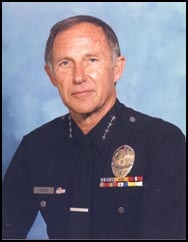
|
|
|
Modern American History and PC Gaming:
Daryl F. Gates' Police Quest
Two Historically Controversial Institutions: The LAPD, and Video Games
Daryl F. Gates, the controversial former Chief of the Los Angeles Police Department
(LAPD), recently passed away on April 16, 2010. Most of the time, when a police
officer has something to say about video games, it's usually at a community crime
awareness meeting where he is going to say something about how incredibly violent
video games are nowadays and that's why we must all be vigilant against super-deadly
youth crime, or that's why video games are bad. But Gates was different. He was
directly involved with Sierra in the creation of many entertaining, high-quality
video games designed to educate players about police procedures and tactics,
including a tactical FPS. He also contributed personal anecdotes from his
police career and included recorded interviews with many of these games.
To make his role in video games even more extraordinary, Gates is not just any
police chief; he is a historical figure who has left his mark on modern policing.
In 1968 Gates was responsible for the historic implementation of the first police
Special Weapons and Tactics (SWAT) unit in the United States, the storied
Metropolitan Division's D Platoon. Subsequently police departments all across
North America have followed the example of LAPD and established special highly
trained units tasked with handling counter-terrorism, high risk warrants,
barricaded suspects, hostage situations, and so on. Today, it would be unthinkable
for a major police department not to have such resources.
In spite of Gates' role in the development of modern policing
he was nevertheless a very controversial figure. Critics tended to portray him
as having a militaristic, as opposed to community-friendly, approach to police
work. For example, in 1987, after an egregious drive-by shooting that resulted
in eight deaths, Gates implemented "Operation Hammer", which involved aggressive
police sweeps of southern LA and many arrests which did not ultimately lead to
any charges. When questioned on a PBS interview if the communities in question
had appreciated his aggressive tactics, Gates replied, "Sure. The good people did
all the time. But the community activists? No. Absolutely not. We were out
there oppressing whatever the community had to be, whether it was blacks, or
Hispanics. We were oppressing them. Nonsense. We're out there trying to save
their communities, trying to upgrade the quality of life of people..." Gates
was ultimately forced to resign as Chief in 1992 following the Rodney King
beating and the subsequent LA riots, and in the aftermath of the Christopher
Commission report which basically stated that the LAPD often used excessive
force, and the Webster Commission, which among other things criticized his
handling of the riots.
Gates tends to be either loved or hated by different groups of
people for the nation-wide impact that he has had on modern policing in the
United States but less known to the general public has been Gates' involvement
with PC gaming. It is so very unusual that a historic police figure devotes
the kind of time and energy over so many years that Gates did with Sierra's Police
Quest series, which eventually became known as "Daryl F. Gates' Police Quest",
then "Daryl F. Gates' Police Quest SWAT", and finally simply 'SWAT". This
progression even covered the transition of the well-known series from an
old-fashioned Sierra "adventure game" to a Night Trap style interactive
movie game to a RTS and finally to a tactical FPS. The manuals that came
with these games tended to be filled with information on actual LAPD police
procedures and extensive anecdotes and commentary from Gates himself, and the
games themselves always featured correct police procedures concerning
use of force as a major aspect of gameplay.
SWAT 2, the RTS, even featured in-game audio
commentary recorded by Gates himself advising the player about what the real
LAPD would try and do in each level.
I was a history major back in college and simulationist
gaming has always been one of my passions. I have gone through the effort
to have acquired all the Sierra games that had varying degrees of authorship
by Gates, jumped through some minor technical hoops to get them to run on my
WinXP machine, and am now in the position to present you with a brief review
of them all.
Police Quest: Open Season
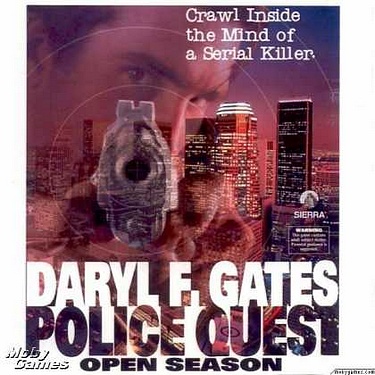 "Police Quest: Open Season", released in 1993, was the first
Sierra Police Quest game created with the involvement of Gates. The gameplay
was exactly in the style of any other adventure games that Sierra had been best
known for at the time. The interface was graphical and mouse driven and the
player needed to click on objects in conjunction with various interaction
commands in order to proceed. Whereas the earlier Police Quest games took
place in the imaginary California town of Lytton with the player playing the
role of small-town cop Sonny Bonds, Open Season takes place in LA, and the player
plays the role of a LA homicide detective. The Police Quest series of adventure
games were always known for emphasizing correct police procedure, but the emphasis
was even greater in Open Season, probably because instead of simply needing to
adhere to imaginary Lytton police procedures which were cobbled together by a
game designer doing some research, the player now had to conform to actual
LAPD procedures, complete with all the paperwork. After you play Open Season
you'll know, down to the document number, which forms a detective must fill
out after examining a crime scene. Open Season is also much more gritty than
the earlier Police Quest games; again, it's easy to tell that authorship of this
series has transitioned from a game designer who probably just did research on
crimes and police procedures to an actual police chief who has seen some pretty
messed up things in his day. Open Season opens with the player examining a
dead, shirtless cop in an alley who has been tortured to death, and a few minutes
later if the player chooses to examine a dumpster in the same alley he will find a
child who has been shot to death probably in a gang crossfire. That is very intense
for 1993 when you consider how around the same time the unrealistic and
cartoony-comedic violence in Mortal Kombat, such as Sub Zero's head-rip, had been
elevated as some kind of serious issue worthy of national attention by the likes of
Joe Lieberman.
"Police Quest: Open Season", released in 1993, was the first
Sierra Police Quest game created with the involvement of Gates. The gameplay
was exactly in the style of any other adventure games that Sierra had been best
known for at the time. The interface was graphical and mouse driven and the
player needed to click on objects in conjunction with various interaction
commands in order to proceed. Whereas the earlier Police Quest games took
place in the imaginary California town of Lytton with the player playing the
role of small-town cop Sonny Bonds, Open Season takes place in LA, and the player
plays the role of a LA homicide detective. The Police Quest series of adventure
games were always known for emphasizing correct police procedure, but the emphasis
was even greater in Open Season, probably because instead of simply needing to
adhere to imaginary Lytton police procedures which were cobbled together by a
game designer doing some research, the player now had to conform to actual
LAPD procedures, complete with all the paperwork. After you play Open Season
you'll know, down to the document number, which forms a detective must fill
out after examining a crime scene. Open Season is also much more gritty than
the earlier Police Quest games; again, it's easy to tell that authorship of this
series has transitioned from a game designer who probably just did research on
crimes and police procedures to an actual police chief who has seen some pretty
messed up things in his day. Open Season opens with the player examining a
dead, shirtless cop in an alley who has been tortured to death, and a few minutes
later if the player chooses to examine a dumpster in the same alley he will find a
child who has been shot to death probably in a gang crossfire. That is very intense
for 1993 when you consider how around the same time the unrealistic and
cartoony-comedic violence in Mortal Kombat, such as Sub Zero's head-rip, had been
elevated as some kind of serious issue worthy of national attention by the likes of
Joe Lieberman.
In the context of the time in which it was released, Open Season manages to push the
envelope in terms of content and realism without being gratuitous or silly. At a time
when adventure games were never particularly realistic, Open Season was innovative by
presenting the player with down-to-the-specific-form realism and detail vis a vis LAPD
homicide investigation procedures. However, as a contemporary gamer, I found that it
was nevertheless very difficult to get into and enjoy Open Season because it suffers
from the same limitations as most old Sierra adventure games, or indeed the general
limitations that characterized all older adventure games. You cannot proceed through
the game unless you know exactly what the game designer wanted you to do at each
specific point and at the same time it's very hard to guess or figure out exactly
what that is; when you open up your game control panel in Open Season the game
actually shows you a now-defunct telephone number you're supposed to call
if you're stuck in the game. Often, as the player you have an idea for what
you'd like your character to do, but you have a very hard time making this happen
through the game interface; getting dismissive error messages from the game for
what seems like ten minutes at a time as I fight the interface to try and make
my character do something is probably my most prominent memory of the whole
adventure game genre. It has gotten to the point that I would rather watch
someone else play through one of these old adventure games on YouTube and
let someone else struggle through one of them than play one of them myself.
Open Season was surely one of the best adventure games, representing the
best of a bygone era in gaming history, but there's definitely a reason why
for the most part nobody makes adventure games any more.
If you're interested in playing Open Season for yourself the easiest way to
go about it would be to buy the Sierra Classic Collection that includes all
the Police Quest adventure games including Open Season. It is set up to be
able to run on a contemporary computer with a minimum of difficulty, and I was
able to get it very cheaply from amazon.com.
Daryl F. Gates' Police Quest: SWAT
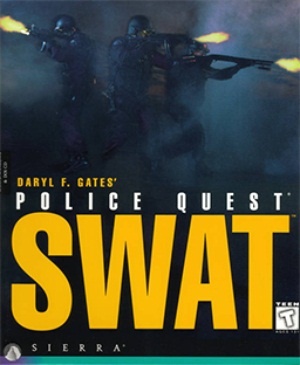 The next Gates title after Open Season was "Daryl F. Gates' Police Quest: SWAT",
which I will refer to here as "SWAT". SWAT starts to break the Police Quest
series away from the traditional adventure game genre, and is instead a
live-action CD-driven FMV that has an adventure-game-style interface. The
game takes place as a series of movies that your computer plays directly off
of a set of several CDs and in order to do well and proceed through the game
you must click on the proper buttons and inventory items at exactly the right
time, although it's not always clear what the correct thing to do is and part
of the challenge of the game is figuring this out. Depending on how well or
poorly you do this, the game will either proceed to video clips showing good
outcomes (such as a successful arrest) or video clips showing bad outcomes
(for example, your commanding officer scolds you for violating procedures).
There was a time when this type of CD-driven interactive movie was very
popular, but as a genre I remember it coming and going very quickly. The best
known example of a game of this genre is probably "Night Trap", which in
1993, much like Mortal Kombat, was considered to be somehow so dangerous
to the people of the United States by Joe Lieberman that it needed to be the
subject of Congressional hearings.
The next Gates title after Open Season was "Daryl F. Gates' Police Quest: SWAT",
which I will refer to here as "SWAT". SWAT starts to break the Police Quest
series away from the traditional adventure game genre, and is instead a
live-action CD-driven FMV that has an adventure-game-style interface. The
game takes place as a series of movies that your computer plays directly off
of a set of several CDs and in order to do well and proceed through the game
you must click on the proper buttons and inventory items at exactly the right
time, although it's not always clear what the correct thing to do is and part
of the challenge of the game is figuring this out. Depending on how well or
poorly you do this, the game will either proceed to video clips showing good
outcomes (such as a successful arrest) or video clips showing bad outcomes
(for example, your commanding officer scolds you for violating procedures).
There was a time when this type of CD-driven interactive movie was very
popular, but as a genre I remember it coming and going very quickly. The best
known example of a game of this genre is probably "Night Trap", which in
1993, much like Mortal Kombat, was considered to be somehow so dangerous
to the people of the United States by Joe Lieberman that it needed to be the
subject of Congressional hearings.
Much like its predecessor SWAT was one of the best games of the genre for
its innovation and realism. During the action sequences the player had to
respond in real time to real SWAT hand signals and use appropriate SWAT tactics
in order to proceed with the game. True to real LAPD SWAT procedures, the player
character would be suspended for a time pending an investigation following even
an in-policy shooting of a suspect. It was even possible to rush ahead like
Lone Wolf McQuade and in some situations make a hostage rescue shot and
save the hostage but this would result in the player character being placed
on probation and a hostile investigation into the shooting.
It's hard to over-state the realism implemented by SWAT, which is to the best
of my knowledge far in excess of any other game. The game doesn't jump from
action sequence to action sequence as is practically demanded of games
nowadays. The majority of the time in the game is spent on repetitious and
mundane drills and exercises punctuated by occasional call-ups, which of
course is a very realistic representation of what would happen if you actually
were a SWAT team member.
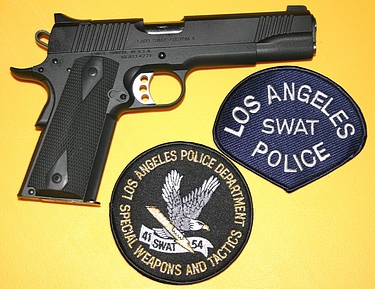 The firearms drills and exercises are real drills and exercises, presented in
enough detail that you could practice them yourself at a range if you wanted
to; they are very similar to the tactical firearms training that I personally
received from a local firearms training institute and from private instructors
with military and law enforcement backgrounds. For example, as part of the
basic firearms training, you are expected to hit a stationary target once
in the torso, once in the head, twice in the torso, or twice in the torso
and once in the head; you usually have anywhere from 1 to 1.5 seconds to
do this. This is exactly what I drilled for four days at the firearms training
institute I attended. Even the terminology is spot-on; it doesn't really make
a difference in terms of gameplay, but the instructor verbally differentiates
between a "double tap" and a "controlled pair", which are both 2 rapid shots
to the torso, but with different degrees of aiming on the second shot. After
going through the basic firearms training encompassing shotguns, rifles, and
pistols once, you may take part in tactical training, which features pistol
courses of fire extremely similar to the Steel Challenge and US Practical
Shooting Association (USPSA) competitions I participate in once a month. For
example, under tactical training, you must complete a course of fire
called "El Presidente" within a certain amount of time, which involves
shooting torso-shaped targets left to right or right to left and then
back again. "El Presidente" is a very well known and widely used tactical
drill. In another drill you must shoot a series of steel targets called
pepper poppers as quickly as possible until they fall (they're weighted so
that only hits near the top of the target will cause them to fall); this
is exactly the same event as is found in many steel shooting competitions. SWAT
has the most realistic and accurate portrayal of tactical firearms training
I have ever seen in a video game. Finally, besides for all of that, the game
lets you zero a rifle, and compensate for windage and elevation when firing
at distant targets with a sniper rifle. Many games nowadays feature sniper
rifles, but very few games let you click on the knobs on the scope in order
to compensate for windage and elevation. Again, an outstanding level of realism
that is very hard to find in shooters nowadays.
The firearms drills and exercises are real drills and exercises, presented in
enough detail that you could practice them yourself at a range if you wanted
to; they are very similar to the tactical firearms training that I personally
received from a local firearms training institute and from private instructors
with military and law enforcement backgrounds. For example, as part of the
basic firearms training, you are expected to hit a stationary target once
in the torso, once in the head, twice in the torso, or twice in the torso
and once in the head; you usually have anywhere from 1 to 1.5 seconds to
do this. This is exactly what I drilled for four days at the firearms training
institute I attended. Even the terminology is spot-on; it doesn't really make
a difference in terms of gameplay, but the instructor verbally differentiates
between a "double tap" and a "controlled pair", which are both 2 rapid shots
to the torso, but with different degrees of aiming on the second shot. After
going through the basic firearms training encompassing shotguns, rifles, and
pistols once, you may take part in tactical training, which features pistol
courses of fire extremely similar to the Steel Challenge and US Practical
Shooting Association (USPSA) competitions I participate in once a month. For
example, under tactical training, you must complete a course of fire
called "El Presidente" within a certain amount of time, which involves
shooting torso-shaped targets left to right or right to left and then
back again. "El Presidente" is a very well known and widely used tactical
drill. In another drill you must shoot a series of steel targets called
pepper poppers as quickly as possible until they fall (they're weighted so
that only hits near the top of the target will cause them to fall); this
is exactly the same event as is found in many steel shooting competitions. SWAT
has the most realistic and accurate portrayal of tactical firearms training
I have ever seen in a video game. Finally, besides for all of that, the game
lets you zero a rifle, and compensate for windage and elevation when firing
at distant targets with a sniper rifle. Many games nowadays feature sniper
rifles, but very few games let you click on the knobs on the scope in order
to compensate for windage and elevation. Again, an outstanding level of realism
that is very hard to find in shooters nowadays.
 In the game, to simulate weapon handling, you use your mouse cursor to click
on targets that pop up on the practice range, or on suspects that appear during
the action sequences. When you click with your mouse your cursor gets displaced
a little bit in order to simulate recoil. Probably the only way in which this
game is not totally realistic is that it's much easier to hit the targets
quickly using your mouse cursor than it would be using an actual gun, especially
using a .45 ACP 1911 as is portrayed in the game. Getting two aimed shots
on target after drawing from concealment within 1.5 seconds using my
Kimber TLE Custom 2 (very similar to the actual pistol used by LAPD SWAT) was
the very best that I was able to do in real life after 4 days of intensive
training. In the game, using the mouse, I was able to do this in less than
half a second, which in my opinion would probably be pushing the limits of
human capability, since in real life to fire a "controlled pair" you would
need to take the time to visually line your sights up and pull your trigger
without jerking it, visually re-acquire your sights after the significant
amount of recoil you'd get from firing a .45, and pull the trigger once more
again being careful not to jerk it. If a person fires a pistol simply pulling
on the trigger as fast as he can, or if the person tries to force the gun down
as it is recoiling to be able to re-acquire his sights faster, he is likely to
shoot very low, or very far off to the left or right. You have to let the pistol
rise and fall on its own rhythm and you have to let the trigger drop the hammer
on the firing pin in its own time. Pistol marksmanship is much more difficult
than the popular media portrays and one of the challenges is that if you rush
any of the steps in the aiming and firing process you will fire an extremely poor shot.
In the game, to simulate weapon handling, you use your mouse cursor to click
on targets that pop up on the practice range, or on suspects that appear during
the action sequences. When you click with your mouse your cursor gets displaced
a little bit in order to simulate recoil. Probably the only way in which this
game is not totally realistic is that it's much easier to hit the targets
quickly using your mouse cursor than it would be using an actual gun, especially
using a .45 ACP 1911 as is portrayed in the game. Getting two aimed shots
on target after drawing from concealment within 1.5 seconds using my
Kimber TLE Custom 2 (very similar to the actual pistol used by LAPD SWAT) was
the very best that I was able to do in real life after 4 days of intensive
training. In the game, using the mouse, I was able to do this in less than
half a second, which in my opinion would probably be pushing the limits of
human capability, since in real life to fire a "controlled pair" you would
need to take the time to visually line your sights up and pull your trigger
without jerking it, visually re-acquire your sights after the significant
amount of recoil you'd get from firing a .45, and pull the trigger once more
again being careful not to jerk it. If a person fires a pistol simply pulling
on the trigger as fast as he can, or if the person tries to force the gun down
as it is recoiling to be able to re-acquire his sights faster, he is likely to
shoot very low, or very far off to the left or right. You have to let the pistol
rise and fall on its own rhythm and you have to let the trigger drop the hammer
on the firing pin in its own time. Pistol marksmanship is much more difficult
than the popular media portrays and one of the challenges is that if you rush
any of the steps in the aiming and firing process you will fire an extremely poor shot.
Just like Open Season, my major frustration with SWAT was with the interface.
During the call-ups, I knew all the SWAT hand signals, I knew all the SWAT
procedures and tactics, and I had my ridiculously fast cursor clicking
skills. I had the benefit of having researched all this stuff on my own for a
long time before coming to this game. However, it was difficult to tell from
the camera shots where your character was supposed to be in relation to the
rest of the team, and whether or not he was properly covering his team
mates. It was difficult to tell when moving up through the level was
appropriate, or when it would be considered moving ahead of the team.
Even loading up and drawing your weapon in order to shoot required clicking
through a series of menus; the game even made you fiddle with the fire-mode
selector on your MP5 every time you clicked on it in your inventory. Even
with multiple attempts I had a lot of difficulty adhering to procedure and
completing the call-ups without getting placed on probation and this difficulty
all boiled down to problems with the interface and confusion about what exactly
the game was trying to portray at any given time.
Indeed, in many ways the game feels more satisfying as an interactive documentary
than as a game. The game featured a lengthy classroom lecture given by an actor
explaining SWAT procedures, use of the LASH communicator device, a rundown of hand
signals, and terminology used to orient around a building (for example,
"side one two, level three"). It even had videos you could watch with
recorded interviews of actual SWAT officers. I felt the game was glorious
as a documentary but plagued with typical adventure-game style problems as a game.
The only way I was able to get SWAT was by ordering a used copy from a third
party vendor off amazon.com. I was able to get it to install on my XP machine
by using a Leisure Suit Larry 7 utility, which I had found after following
a link from SierraFiles. Without that utility the installer window won't
work properly and you will not be able to install the game. Also, during
installation, the installer will ask to check your system to make sure the
game can run on it, but you must skip the system check or else the installer
will crash. After taking these steps, the game seemed to work normally.
Police Quest: SWAT 2
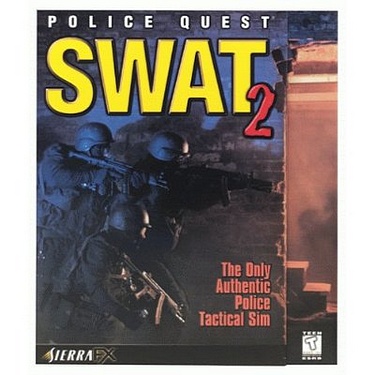 In SWAT 2, the series made a very significant transition from being basically
an adventure game to becoming a RTS. SWAT 2 allowed the player to play through
either a LAPD SWAT or a Terrorist campaign. In either case, the game introduced
strong management elements which had not been present at all in earlier games in
the series. Both the terrorists and the LAPD have a budget which can be spent
on training, equipment, and which must be used in order to deploy teams. The
player starts the game with a certain budget and basically must make it last
for the entire game; if either organization exhausts its budget and doesn't have
enough money to deploy teams for the upcoming level, the campaign ends, and in
the case of the LAPD public outrage over government spending makes the LAPD chief
resign, which is another example of the incredible attention to detail and even
mundane realism that characterizes all the games that Gates was involved in. Both
the terrorists and the LAPD start with a certain number of personnel with background
stories and skills, who may be trained using funds from the budget, who may be
equipped on an individual basis with equipment purchased from the budget, or who
may be removed from the game through death or disability. Much as Gates himself
was forced to resign because of the 1992 LA Riots, if any of the SWAT missions
goes particularly awry, the campaign ends and the LAPD chief is forced to resign.
In SWAT 2, the series made a very significant transition from being basically
an adventure game to becoming a RTS. SWAT 2 allowed the player to play through
either a LAPD SWAT or a Terrorist campaign. In either case, the game introduced
strong management elements which had not been present at all in earlier games in
the series. Both the terrorists and the LAPD have a budget which can be spent
on training, equipment, and which must be used in order to deploy teams. The
player starts the game with a certain budget and basically must make it last
for the entire game; if either organization exhausts its budget and doesn't have
enough money to deploy teams for the upcoming level, the campaign ends, and in
the case of the LAPD public outrage over government spending makes the LAPD chief
resign, which is another example of the incredible attention to detail and even
mundane realism that characterizes all the games that Gates was involved in. Both
the terrorists and the LAPD start with a certain number of personnel with background
stories and skills, who may be trained using funds from the budget, who may be
equipped on an individual basis with equipment purchased from the budget, or who
may be removed from the game through death or disability. Much as Gates himself
was forced to resign because of the 1992 LA Riots, if any of the SWAT missions
goes particularly awry, the campaign ends and the LAPD chief is forced to resign.
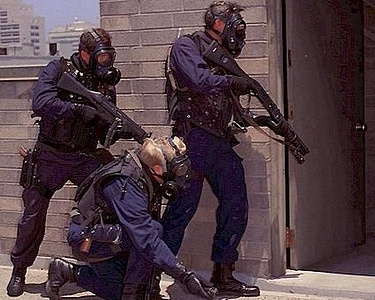 Besides for budget issues, during the SWAT campaign the player must correctly
manage D Platoon according to LAPD policies. Each five-man entry team is called
an "element", and you cannot field an element without an "element leader". In
order for an officer to act as an "element leader" he or she must have
outstanding levels of skill in the vast array of skills implemented in
the game (including "sidearms", "submachine guns", "shotguns",
"dynamic entry", "CS gas", "hand to hand combat", "first aid", and "explosives"),
and must complete an element leader qualification course, which takes the
character out of the game for one mission. Therefore, it is possible for the
SWAT campaign to end if, as the player, you didn't plan ahead, and had only a
couple element leaders who are for some reason unavailable in the next upcoming
mission, either because they've been killed or injured, or because they shot a
suspect in the previous mission and are now suspended for a mission while the
shooting is investigated per LAPD policy, where any time an officer shoots a
suspect there is a mandatory suspension and investigation. (During the
terrorist campaign, terrorists who have been badly injured on a mission are
considered mangled for life and are likewise removed from the roster since
it is assumed that they don't have access to the best medical care.) Since
being an element leader requires very high levels of skill across the board, having
enough element leaders for any eventuality usually requires that you spend
much of your budget on training for your most promising officers so that there
will be enough officers who are eligible for element leader training in the
first place. But the details don't end there; officers who are deployed on
a mission collect additional hazard pay, officers may be certified as
EMTs, K9 handlers, snipers, or bomb disposal experts. All of these qualifications
have requisite skill levels in various specific skills. As a friend of mine
commented, "after playing that game you'll be ready to manage a police department!"
Besides for budget issues, during the SWAT campaign the player must correctly
manage D Platoon according to LAPD policies. Each five-man entry team is called
an "element", and you cannot field an element without an "element leader". In
order for an officer to act as an "element leader" he or she must have
outstanding levels of skill in the vast array of skills implemented in
the game (including "sidearms", "submachine guns", "shotguns",
"dynamic entry", "CS gas", "hand to hand combat", "first aid", and "explosives"),
and must complete an element leader qualification course, which takes the
character out of the game for one mission. Therefore, it is possible for the
SWAT campaign to end if, as the player, you didn't plan ahead, and had only a
couple element leaders who are for some reason unavailable in the next upcoming
mission, either because they've been killed or injured, or because they shot a
suspect in the previous mission and are now suspended for a mission while the
shooting is investigated per LAPD policy, where any time an officer shoots a
suspect there is a mandatory suspension and investigation. (During the
terrorist campaign, terrorists who have been badly injured on a mission are
considered mangled for life and are likewise removed from the roster since
it is assumed that they don't have access to the best medical care.) Since
being an element leader requires very high levels of skill across the board, having
enough element leaders for any eventuality usually requires that you spend
much of your budget on training for your most promising officers so that there
will be enough officers who are eligible for element leader training in the
first place. But the details don't end there; officers who are deployed on
a mission collect additional hazard pay, officers may be certified as
EMTs, K9 handlers, snipers, or bomb disposal experts. All of these qualifications
have requisite skill levels in various specific skills. As a friend of mine
commented, "after playing that game you'll be ready to manage a police department!"
The SWAT campaign enforces adherence to real LAPD policies, just like every
earlier Gates game. If an officer shoots a suspect who has his weapon in a
high ready position (which basically means that he's aiming at someone) that
shooting is in-policy and the officer will be suspended for 1 mission for an
investigation that is basically a formality. But if god forbid an officer
shoots a suspect who has a weapon in a low ready (which means he's holding
a weapon but isn't pointing it at anyone), who doesn't have a weapon in
hand, or if an officer somehow ends up shooting a civilian, another officer,
or a police dog, that officer can be subject to disciplinary action up to
and including termination from the force and you lose him or her from your
roster just as if he or she had been killed in action. Moreover, each
policy transgression committed by LAPD officers has an impact on the
overall evaluation of the entire mission, and if even a single mission gets
a poor evaluation, the campaign can end with the resignation of the LAPD
chief. You can even get in trouble for using too much CS gas in a
building! This is absolutely realistic and true to life; I once investigated
this and asked an actual former SWAT team member about this issue and he
basically told me that if you put too much CS gas in a building it can
displace the oxygen and injure the suspects, so that is forbidden under
procedures. Additionally, the LAPD is unable to prosecute or effectively
investigate the terrorists without evidence and unless you make your officers
grab items of evidence before each mission ends your ending after the final
mission of the campaign gradually becomes more and more unsatisfying.
 The SWAT 2 missions and levels are often based on real famous events involving
the LAPD. The game manual goes into detail both about the historical event
that each mission is based on, and the mission as presented in-game. The
SWAT 2 manual deserves special mention because in and of itself, it is like
a short history book detailing the most famous LAPD SWAT call-ups, complete
with personal anecdotes and memoirs from Gates himself. I remember Gates'
anecdote about the time that he brought Barbara Bush to watch SWAT clear
the residences of some squatters who had been involved with a lot of
drugs. He describes how Bush jumped, surprised, and hugged him when
the flashbangs went off as SWAT made entry, and how after the residences
were clear Bush entered them and was, like everyone who sees it for the
first time usually is, shocked by the level of squalor and degradation
that a human being may fall to when he or she is addicted to drugs. I guess
that from that point on, whenever Bush said, "Just say no!", she probably
believed in what she was saying, as opposed to her just cynically repeating
a political catchphrase! Even if a person had no intention to play the
game, I would recommend everyone acquire a legitimate copy of SWAT that
comes with a manual just to have the manual as a piece of modern history
and something of a chronicle of social conflict and riots in LA.
The SWAT 2 missions and levels are often based on real famous events involving
the LAPD. The game manual goes into detail both about the historical event
that each mission is based on, and the mission as presented in-game. The
SWAT 2 manual deserves special mention because in and of itself, it is like
a short history book detailing the most famous LAPD SWAT call-ups, complete
with personal anecdotes and memoirs from Gates himself. I remember Gates'
anecdote about the time that he brought Barbara Bush to watch SWAT clear
the residences of some squatters who had been involved with a lot of
drugs. He describes how Bush jumped, surprised, and hugged him when
the flashbangs went off as SWAT made entry, and how after the residences
were clear Bush entered them and was, like everyone who sees it for the
first time usually is, shocked by the level of squalor and degradation
that a human being may fall to when he or she is addicted to drugs. I guess
that from that point on, whenever Bush said, "Just say no!", she probably
believed in what she was saying, as opposed to her just cynically repeating
a political catchphrase! Even if a person had no intention to play the
game, I would recommend everyone acquire a legitimate copy of SWAT that
comes with a manual just to have the manual as a piece of modern history
and something of a chronicle of social conflict and riots in LA.
SWAT 2 features hostage negotiation, which is something that few games have ever
implemented in a flexible and realistic manner. As SWAT, since the game takes
place before the era of ubiquitous cell phones, in many missions you have the
ability to send an officer to toss a "throw phone", which is basically a phone
in a box with a really long cord, somewhere where a terrorist is likely to find
it so that negotiations can begin. It is possible to offer food, media coverage,
an escape vehicle, or cash to the terrorists. It is possible to actually grant
these things, or else more commonly use them as a trap for the terrorists. As
the terrorists, the computer-controlled D Platoon will attempt to negotiate
with you, and it is possible to gain the same above mentioned assets by not
opening fire, and by gradually releasing hostages.
SWAT 2 is probably the only video game ever that implements Stockholm syndrome
among hostages. During the terrorist campaign, you can direct your terrorists
to take hostages who you can later execute, release in exchange for concessions
from the police, or drag back to your terrorist training camp for
Patty Hearst-style detention and isolation. During each mission, you can
give your hostages a leaflet from your terrorist organization, or give them
food you have gained from hostage negotiations with the police. If you do
these things there is a chance that some of the hostages will succumb
to Stockholm syndrome and resist the police when the police attempt to
rescue them. Gates actually mentions the specific example of Patty Hearst
several times in the game manual, who was an heiress who had been abducted
by some domestic terrorists and after an extended period of captivity and
abuse eventually joined the terrorist organization and took part in terrorist
acts, and mentions "Stockholmed" hostages in the manual as well. According
to the FBI, 27% of hostages exhibit Stockholm syndrome, so while its
implementation in-game might seem bizarre initially, it's probably more realistic
to include it as part of the game than not implement it at all.
Most tactical games don't go very far in terms of implementing support, such
as armored vehicles or helicopters called in by infantry. This neglect is
probably rather unrealistic. SWAT 2 is one of the few games I am familiar
with that allows the LAPD to call in armored vehicles or helicopters for
support on many of the missions, budget permitting. The helicopter can
circle the level and provide recon, or it can land and up to 5 officers
who are equipped with rappelling harnesses can climb aboard and rappel
down elsewhere on the map, which allows for very rapid deployment of
forces. A historically accurate armored truck fitted with a makeshift
battering ram (D Platoon's actual first armored support vehicle, a used
armored truck purchased for next to nothing and modified for ramming holes
in buildings by the LAPD) can be called in to make an additional point of
entry on certain buildings. Even better in terms of realism, both support
vehicles can actually be destroyed by the terrorists in certain circumstances,
rendering them unavailable for the rest of the mission.
In spite of this tremendous realism and innovation, SWAT 2's gameplay is rather
poor by today's standards. The isometric perspective makes it difficult to
tell whether or not a character has line of sight through a particular door
or window. It's confusing and difficult to issue effective group commands
and often as I played SWAT 2 I ended up putting the game speed on the minimum
setting and issuing multiple individual commands to open fire to my squads.
The game manual boasts that all the characters in the game have behind-the-scenes
character traits that will cause them to react unpredictably but still along
general personality lines in chaotic and violent situations, but what really
seems to happen is that characters usually fail to act of their own initiative,
and when they do they act strangely. I've seen SWAT officers making entry
into a building fail to open fire on suspects with weapons in high ready,
which is totally unrealistic, and I've also seen terrorists crouched behind
cover with body armor, grenades, automatic rifles, and combat knives surrender
to SWAT without putting up a fight. Like I said, I mostly ended up
micro-managing each character. In spite of the huge level of detail and realism
elsewhere in the game, it's still not possible to make your squads do things
that most modern gamers would expect them to be able to do; during the SWAT
campaign your SWAT officers can mirror doorways, pry open doors, blow up doors,
and automatically alternately run the walls to the left and the right when you
order a group of them to enter a room, but you can't order them to stack up and
throw a flashbang into the room before making entry. You can equip them with
flashbangs, they can throw the flashbangs, and the flashbangs work, but there's
no way to use them in conjunction with a room entry on a door that is closed.
During the terrorist campaign you must accomplish various objectives (for
example, force a hostile network executive to air your terrorist propaganda
tape) but it's pretty much impossible to figure out how to do these things
if you didn't read the level guide in the game manual; SWAT 2's terrorist
campaign can take the inscrutable scripting and interface-rage of the adventure
game genre to new and epic heights.
SWAT 2 seemed to install and run without any problems on my XP machine.
SWAT 3
The final game of the series that still had the involvement of the LAPD was
SWAT 3, which was a tactical FPS. It was also the first title to drop
"Police Quest" from its name entirely. SWAT 3 allowed for real-time FPS
and squad combat, where the player, as the Element Leader, controlled Red and
Blue, two small squads, which could be ordered to separately or as a unit
(as "gold") to clear rooms, cover particular directions or doorways, mirror
under doors, and thankfully, to flash and clear, breach and clear, or gas
and clear, which in my opinion were the commands most sorely lacking from
SWAT 2. SWAT 3 remains one of the most realistic and challenging tactical
FPS games available today; I have never managed to complete the final level
of SWAT 3 in spite of (obviously) a lot of time spent playing.
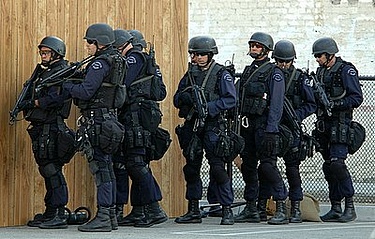 Many realistic aspects of SWAT 3, which came out in 2001, either have not been
widely modeled even today in tactical FPS games, or else have only recently been
modeled. Over-penetration of rounds fired is one such aspect. In police or
civilian self-defense shootings, especially in a home defense scenario,
over-penetration, when the rounds the officer or citizen fires penetrate
through walls (or indeed through bad guys) and fly out of the area to threaten
innocent bystanders, is a major concern because legally the shooter is responsible
for all of the rounds that he or she fires. If you shoot someone invading your
home with an AR 15, and your 5.56 NATO FMJ round hits the home invader, exits
out his back, punches through your screen door, and hits your neighbor across
the street, you would be legally and morally responsible for hitting an
innocent person. While this concern about over-penetration might seem
relatively manageable for you and me if we're an individual firing at one home
invader down the hall, it is a much more serious concern for SWAT, who often
use rifles in chaotic and deadly close combat situations. If a ten man team
of officers equipped with M4 carbines is going to storm a dark, cluttered apartment
in a housing project and they encounter armed resistance from multiple individuals,
there is a much higher probability of stray rounds endangering innocent
bystanders. To manage these risks, police and citizens who are concerned
with home defense will usually load their rifles with hollow point or
frangible ammunition instead of military ball ammo. There are many games which
let the player choose between military ball and jacketed hollow point, but
SWAT 3 has even more realism and detail. SWAT 3 also differentiated between
dry wall, wood, glass, and cement, and had different specific penetration
characteristics for .45 ACP fired from a sidearm, 9mm parabellum fired from
a submachinegun, or 5.56 NATO fired from a rifle, with all of these cartridges
being available in both FMJ and JHP and thereby having different penetration
characteristics. And unlike, say, Rainbow Six Vegas 2 where overpenetration
is just a means to kill bad guys behind cover, in SWAT 3 your main concern with
overpenetration is hitting someone you shouldn't, which includes armed suspects
who haven't had a chance to surrender yet. SWAT 3 is more true to life in terms
of representing the legal obligations and constraints that anybody would face
in our society if they ever used a firearm in a defensive and tactical
context. SWAT 3 is also one of the very first games that implemented
less-than-lethal munitions; as element leader, you could elect to take an AR
that was modified, essentially, to fire flexible-baton type blunt trauma
inflicting rounds.
Many realistic aspects of SWAT 3, which came out in 2001, either have not been
widely modeled even today in tactical FPS games, or else have only recently been
modeled. Over-penetration of rounds fired is one such aspect. In police or
civilian self-defense shootings, especially in a home defense scenario,
over-penetration, when the rounds the officer or citizen fires penetrate
through walls (or indeed through bad guys) and fly out of the area to threaten
innocent bystanders, is a major concern because legally the shooter is responsible
for all of the rounds that he or she fires. If you shoot someone invading your
home with an AR 15, and your 5.56 NATO FMJ round hits the home invader, exits
out his back, punches through your screen door, and hits your neighbor across
the street, you would be legally and morally responsible for hitting an
innocent person. While this concern about over-penetration might seem
relatively manageable for you and me if we're an individual firing at one home
invader down the hall, it is a much more serious concern for SWAT, who often
use rifles in chaotic and deadly close combat situations. If a ten man team
of officers equipped with M4 carbines is going to storm a dark, cluttered apartment
in a housing project and they encounter armed resistance from multiple individuals,
there is a much higher probability of stray rounds endangering innocent
bystanders. To manage these risks, police and citizens who are concerned
with home defense will usually load their rifles with hollow point or
frangible ammunition instead of military ball ammo. There are many games which
let the player choose between military ball and jacketed hollow point, but
SWAT 3 has even more realism and detail. SWAT 3 also differentiated between
dry wall, wood, glass, and cement, and had different specific penetration
characteristics for .45 ACP fired from a sidearm, 9mm parabellum fired from
a submachinegun, or 5.56 NATO fired from a rifle, with all of these cartridges
being available in both FMJ and JHP and thereby having different penetration
characteristics. And unlike, say, Rainbow Six Vegas 2 where overpenetration
is just a means to kill bad guys behind cover, in SWAT 3 your main concern with
overpenetration is hitting someone you shouldn't, which includes armed suspects
who haven't had a chance to surrender yet. SWAT 3 is more true to life in terms
of representing the legal obligations and constraints that anybody would face
in our society if they ever used a firearm in a defensive and tactical
context. SWAT 3 is also one of the very first games that implemented
less-than-lethal munitions; as element leader, you could elect to take an AR
that was modified, essentially, to fire flexible-baton type blunt trauma
inflicting rounds.
It is possible to lose the respect of your officers by bungling various
aspects of SWAT procedure. As the element leader, you must radio in downed
suspects, hostages, or officers. In order to do this you must work through a
radio communication tree in real time. If you report using incorrect
terminology by picking the wrong term from the tree, for example if you have
an officer down but report him as "neutralized", or you have a suspect
neutralized but report him as "down", you are penalized. You are also
penalized if you fail to report and collect evidence. The police procedure
element of SWAT 3 isn't as cumbersome as in the earlier games, but it is
still definitely present.
The AI in SWAT 3 was greatly improved from SWAT 2. The officers under your
command run the walls upon making entry. They shoot as soon as a suspect
brings his weapon into a high ready, but never shoot when they shouldn't. The
suspects' AI is better as well. If you move away from your team, come face to
face with a suspect, and order him to surrender, he usually won't. Suspects
tend to only surrender if multiple officers are pointing weapons at them, or
if you come up behind them and you order them to surrender from directly behind
them. Even if you shot the suspect multiple times with the less-than-lethal
munitions, if you were alone, the suspect would still actually wait until you
were reloading and then try to shoot you, instead of simply surrendering because
you hit him with the less-than-lethal. Many suspects will only surrender if
they're incapacitated by CS gas and at the same time they're being covered by
multiple officers. For 2001 that is outstanding AI, and it is still very satisfying
to play with today.
The SWAT 3 manual, following the tradition of the previous game's manual, was of
outstanding informative quality. SWAT 3 was actually the first game in the series
that I played and the game manual was practically a textbook on police procedure
that equipped me with adequate knowledge to play all the preceding SWAT games. The
manual articulates, for example, why all civilians and hostages are handcuffed
when SWAT encounters them, but how that procedure differs for children or badly
injured individuals. Even better, the Game of the Year edition comes with a
second CD that is filled with educational movies about SWAT tactics. Even if
someone never plays the game, SWAT 3 could be a good buy for someone who just
wants text and documentary movies about how SWAT operates.
SWAT 3 is recent enough of a game that no special procedures are needed to run
the game on a contemporary computer.
To date, there was one more sequel in this series of games, but Gates, and
the LAPD, was not involved. SWAT 4 was an excellent game, and one of my all
time favorites, with many fine mods, but is beyond the scope of this article.
Final Thoughts
On a personal note, the SWAT series of games are some of my favorite
games of all time. I learned a great deal about firearms and tactics and the
more I played the more curious I became about the details and why things are done
the way that they are. I certainly gained a great deal of respect for the police
and began to understand their actions as reported periodically in the media a
little bit more. Because of the thirst for knowledge that these games engendered
I took initiative to learn more and completed multiple tactical firearms classes
and participate in shooting sports. These games educated me and lead me to
explore new hobbies and develop new skills.
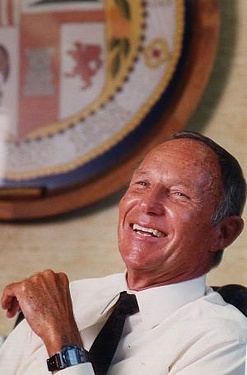 Gates stated in the SWAT 2 manual that the reason he was involved in game design
was because he wanted to educate the public about realistic aspects of dangerous
police work. At the time, and even today, there was a widespread perception among
the public that police, especially the LAPD, were trigger happy, brutal, and
bloodthirsty. By implementing games that emphasized police policy and procedures
and restrictions on use of deadly force, Gates intended to educate gamers about
the restraint that police must use even in very intense tactical situations.
Gates wrote that he wanted gamers to realize the great difficulty and personal
risk undertaken by SWAT officers to resolve violent situations; that while
the safest way for officers to end a situation might be to use overwhelming
and indiscriminate force (for example, simply leveling a building with
anti-tank weaponry instead of making entry and attempting to arrest, rather
than kill, suspects) they do not do this because fundamentally "SWAT is a
lifesaving organization." Gates demonstrates very high hopes and expectations
regarding the educational power and pro-social value of video games at a time
when most big name politicians would be quick to wring their hands and chime in
about how violent video games were stealing away the innocence and youth of the
nation's children. When the evening news headlines were mobilizing parents with
lies about Night Trap, Gates, a man who as chief once vowed to never be
bullied by "crummy politicians", and never, in a city polarized by race hate
and vicious politics, to throw any of his officers to the wolves, demonstrated
the courage of his convictions and once again defied the two-bit politics of the
day by being involved with the design of extremely high quality video games that
were both interesting to play but also pro-social and genuinely educational for
many years. It is so rare to ever see someone holding high office take a stand
on principle, or even do something for the edification of society, without it
all being cheap, cynical manipulation of the lowest common denominator. Is it
any wonder that such a man saw value in video games and personally invested in
their design, even while Washington was still reverberating with Lieberman's
anti-video-game screed?
Gates stated in the SWAT 2 manual that the reason he was involved in game design
was because he wanted to educate the public about realistic aspects of dangerous
police work. At the time, and even today, there was a widespread perception among
the public that police, especially the LAPD, were trigger happy, brutal, and
bloodthirsty. By implementing games that emphasized police policy and procedures
and restrictions on use of deadly force, Gates intended to educate gamers about
the restraint that police must use even in very intense tactical situations.
Gates wrote that he wanted gamers to realize the great difficulty and personal
risk undertaken by SWAT officers to resolve violent situations; that while
the safest way for officers to end a situation might be to use overwhelming
and indiscriminate force (for example, simply leveling a building with
anti-tank weaponry instead of making entry and attempting to arrest, rather
than kill, suspects) they do not do this because fundamentally "SWAT is a
lifesaving organization." Gates demonstrates very high hopes and expectations
regarding the educational power and pro-social value of video games at a time
when most big name politicians would be quick to wring their hands and chime in
about how violent video games were stealing away the innocence and youth of the
nation's children. When the evening news headlines were mobilizing parents with
lies about Night Trap, Gates, a man who as chief once vowed to never be
bullied by "crummy politicians", and never, in a city polarized by race hate
and vicious politics, to throw any of his officers to the wolves, demonstrated
the courage of his convictions and once again defied the two-bit politics of the
day by being involved with the design of extremely high quality video games that
were both interesting to play but also pro-social and genuinely educational for
many years. It is so rare to ever see someone holding high office take a stand
on principle, or even do something for the edification of society, without it
all being cheap, cynical manipulation of the lowest common denominator. Is it
any wonder that such a man saw value in video games and personally invested in
their design, even while Washington was still reverberating with Lieberman's
anti-video-game screed?
|
|
|
|
-- Wounded Ronin (07/04/2010)
|
|
|
|
|
|
|
|
|
|
|
|
|
Toy Fair Catalogs
|
|

|
|
|
|
|
|
Hobby Catalogs
|
|

|
|
|
|
|
|
Magazine Archive
|
|

|
|
|
|
Featured Toy Lines
|
|

|
|

|
|

|
|

|
|

|
|

|
|

|
|
|
New Additions
|

|
Playthings Magazine
March, 1987
|
|
|

|
Play Meter Magazine
April 15, 1985
|
|
|

|
Yahoo! Internet Life Magazine
August, 2001
|
|
|

|
The Pinball Trader
July, 1986
|
|
|

|
IEEE Internet Computing
July/August, 2005
|
|
|

|
Science Activities
November, 1973
|
|
|

|
NASA Station Break Newsletter
June, 1991
|
|
|

|
Countdown Magazine
December, 1990
|
|
|

|
The Bisquick Banner
March/April, 1984
|
|
|

|
NASA Activities Newsletter
September, 1983
|
|
|

|
Egon
w/ Symmetrical Book Stacking
|
|
|
Conventions
|
|

|
|

|
|

|
|

|
|

|
|

|
|

|
|

|
|

|
|

|
|

|
|

|
|
|
|